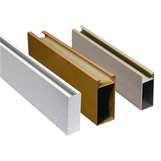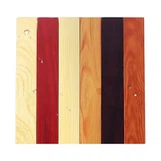Hey there! As an aluminum solid plate supplier, I often get asked about how to calculate the cost of an aluminum solid plate. It's not as complicated as it might seem at first glance, but there are several factors that come into play. In this blog post, I'll break down the process step by step so you can have a better understanding of what goes into the pricing of these plates.
1. Material Costs
The first and most obvious factor is the cost of the aluminum material itself. Aluminum prices fluctuate based on the global market, supply and demand, and the quality of the aluminum. High - quality aluminum with specific alloy compositions will cost more than standard aluminum.
The price of aluminum is usually quoted per pound or per kilogram. To figure out the material cost for your plate, you first need to know the volume of the plate. The volume of a rectangular solid plate can be calculated using the formula (V = l\times w\times h), where (l) is the length, (w) is the width, and (h) is the height (or thickness) of the plate.
Once you have the volume, you need to convert it to weight. The density of aluminum is approximately (2.7) grams per cubic centimeter ((g/cm^{3})) or (0.0975) pounds per cubic inch ((lb/in^{3})). So, if your volume is in cubic centimeters, you multiply it by (2.7) to get the weight in grams. If it's in cubic inches, multiply by (0.0975) to get the weight in pounds.
After getting the weight, you multiply it by the current market price of aluminum per pound or per kilogram. For example, if the market price of aluminum is (2) dollars per pound and your plate weighs (10) pounds, the material cost for the plate would be (2\times10=$20).
2. Manufacturing Costs
Manufacturing an aluminum solid plate involves several processes, and each of these processes adds to the cost.
- Casting: This is the initial process where the aluminum is melted and poured into a mold to form the basic shape of the plate. The cost of casting depends on the size and complexity of the mold, as well as the energy required to melt the aluminum.
- Rolling: After casting, the plate usually goes through a rolling process to achieve the desired thickness and smoothness. The cost of rolling includes the cost of the rolling equipment, labor, and energy.
- Finishing: Finishing processes such as polishing, anodizing, or painting can also add to the cost. For example, anodizing is a process that creates a protective layer on the aluminum surface, which not only enhances its appearance but also increases its durability. However, anodizing requires special equipment and chemicals, so it comes at an additional cost.
3. Size and Thickness
The size and thickness of the aluminum solid plate have a direct impact on its cost. Larger and thicker plates generally cost more. This is because they require more raw material, and the manufacturing processes are more time - consuming and energy - intensive.
For instance, a (4\times8) foot aluminum solid plate will cost more than a (2\times4) foot plate, assuming the same thickness. Similarly, a plate that is (1) inch thick will cost more than a plate that is (1/4) inch thick.
If you're interested in Aluminum Composite Panel 4x8, you'll notice that due to its larger size, it has a different cost structure compared to smaller panels.
4. Quantity
The quantity of plates you order also affects the cost. When you order in bulk, you can often get a better price per unit. This is because suppliers can take advantage of economies of scale. They can reduce the per - unit cost of manufacturing, packaging, and shipping when producing a large number of plates at once.
For example, if you order 10 aluminum solid plates, the cost per plate might be (50) dollars. But if you order 100 plates, the cost per plate might drop to (40) dollars.
5. Market Demand and Supply
Like any other product, the cost of aluminum solid plates is influenced by market demand and supply. If the demand for aluminum solid plates is high and the supply is low, the prices will go up. On the other hand, if there is an oversupply of plates in the market, the prices will likely decrease.
External factors such as economic conditions, industry trends, and government policies can also affect the demand and supply of aluminum solid plates. For example, if there is a boom in the construction industry, the demand for aluminum plates for building facades and roofing will increase, which may lead to higher prices.
6. Transportation Costs
Transportation costs are another important factor to consider. The cost of transporting the aluminum solid plates from the factory to your location depends on the distance, the mode of transportation (truck, train, or ship), and the weight and volume of the plates.
If you're located far from the manufacturing facility, the transportation cost can be a significant portion of the total cost. Additionally, if the plates are very large or heavy, special transportation arrangements may be required, which can further increase the cost.


7. Additional Costs
There may be other additional costs depending on your specific requirements. For example, if you need custom - cut plates, the supplier will need to use special cutting equipment, which will add to the cost. Also, if you require special packaging to protect the plates during transportation, that will also incur an extra cost.
Calculating the Total Cost
To calculate the total cost of an aluminum solid plate, you need to add up all the costs we've discussed above:
[Total\ Cost=Material\ Cost + Manufacturing\ Cost+Size\ and\ Thickness\ - related\ Cost+Quantity\ - related\ Cost+Transportation\ Cost+Additional\ Costs]
Let's say you want to order a (4\times8) foot, (1/2) inch thick aluminum solid plate. The material cost based on the current market price of aluminum is ($50). The manufacturing cost, including casting, rolling, and finishing, is ($30). The size and thickness of the plate add an extra ($20) to the cost. Since you're ordering only one plate, there is no quantity - based discount. The transportation cost to your location is ($15), and you don't have any additional costs. So, the total cost of the plate would be (50 + 30+20 + 15=$115).
If you're in the market for Aluminum Composite Roof Panel or Factory Aluminum Composite Panels, the cost - calculation principles are similar, but there may be some differences due to the specific features and manufacturing processes of these products.
If you're interested in purchasing aluminum solid plates, I'd love to have a chat with you about your specific needs. Whether you're a contractor working on a large - scale construction project or a DIY enthusiast looking for a small piece of aluminum plate, I can help you figure out the best options and the most accurate cost. Just reach out, and we can start the procurement discussion.
References
- Aluminum Association. (2023). Aluminum Properties and Applications.
- Metal Supermarkets. (2023). Understanding Aluminum Pricing.




